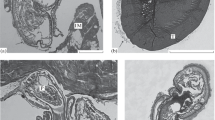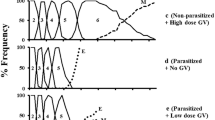Abstract
Very long virus-like filaments were found in calyx region of the reproductive tracts of the braconid parasitoid,Microplitis mediator Haliday, which attacks the Noctuid,Pseudaletia (=Leucania) separata Walker. These filaments are nuclear in origin; Feulgen and methyl-green pyronin reactions revealed cytochemically the presence of DNA. Filaments are attached to the surface of the chorion of an egg until hatching and function to suppress the encapsulation reaction of the host. Furthermore, it was observed that serosal cells, 18-h and 24-h from oviposition, released substances possibly related to the inhibition of encapsulation.
Résumé
De très longs filaments semblables à des virus ont été trouvés dans le calice des organes reproducteurs femelles du braconide parasitoïde,Microplitis mediator Haliday, qui attaque les larves de la NoctuellePseudaletia (=Leucania) separata Walker. Ces filaments ont leur origine dans le noyau de la cellule. L'examen cytochimique (Feulgen et vert de méthyl) atteste la présence d'ADN dans les filaments. Les filaments adhèrent à la surface du chorion des œufs jusqu'à l'éclosion et ont pour fonction de supprimer la réaction d'encapsulation de l'hôte. D'autre part, on observait que les tératocytes, 18 h et 24 h après la ponte secrétaient des substances inhibitrices de l'encapsulation.
Similar content being viewed by others
References
Edson, K. M., Vinson, S. B., Stoltz, D. B. &Summers, M. D. — 1980. Virus in a parasitoid wasp: suppression of the cellular immune response in the parasitoid's host. —Science, 211, 582–583.
Lynn, D. C. &Vinson, S. B. — 1977. Effect of temperature, host age, and hormones upon the encapsulation ofCardiochiles nigriceps eggs byHeliothis spp. —J. Invertebr. Pathol., 29, 50–55.
Norton, W. N. &Vinson, S. B. — 1977. Encapsulation of a parasitoid egg within its habitual host: an ultrastructural investigation. —J. Invertebr. Pathol., 30, 55–67.
Rotheram, S. — 1973. The surface of the egg of a parasitic insect. II. The ultrastructure of the particulate coat on the egg ofNemeritis. —Proc. Roy. Soc. London, 183, 195–204.
Salt, G. — 1973. Experimental studies in insect parasitism. XVI. The mechanism of the resistance ofNemeritis to defense reactions. —Proc. Roy. Soc. London, 183, 337–350.
Stoltz, D. B., Vinson, S. B. &MacKinnon, E. A. — 1976. Baculovirus-like particles in the reproductive tracts of female parasitoid wasps. —Can. J. Microbiol., 22, 1013–1023.
Stoltz, S. B. &Vinson, S. B. — 1979. Viruses and parasitism in insects. —Adv. Virus Res., 24, 125–171.
Vinson, S. B. — 1977.Microplitis croceipes: inhibitions of theHeliothis zea defense reaction toCardiochiles nigriceps. —Exp. Parasitol., 41, 112–117.
Author information
Authors and Affiliations
Rights and permissions
About this article
Cite this article
Tanaka, T. Morphology and functions of calyx fluid filaments in the reproductive tracts of endoparasitoid,Microplitis mediator [Hym.: Braconidae] . Entomophaga 32, 9–17 (1987). https://doi.org/10.1007/BF02390926
Received:
Accepted:
Issue Date:
DOI: https://doi.org/10.1007/BF02390926




